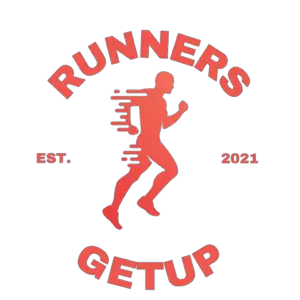This post contains affiliate links.
You want to buy a pair of running shoes but you either can’t find the model you’re looking for in stores or don’t really have time to go out. The next option is to buy them online. But how do you get the right shoes when buying online?
To get the right running shoes when buying online, you have to get the exact measurement of your foot, determine your running gait, and know what type of running you are going to do with your running shoes.
If you don’t know how to go about all those, stick along, cause we will go into detail including finding the right size, support level, and type of running shoe.
How to Choose a Running Shoe Online
Whether you’re buying at a physical store or buying online, there are a plethora of shoes to choose from which is why getting an idea of what they are will go a long way in choosing the right running shoes.
1. Know the running surface in the area you’ll be running in

Before you pick up a shoe, check out the running area that you’ll be running in.
There are basically two choices for this one, trail or road. But sometimes there are routes with a mix of road and buffed-out trail where you won’t be needing deep lugs but can use a little bit more cushioning for the road.
In that case, you can use a commuter shoe like the Hoka Speedgoat 4. It has a decent amount of stack height to provide cushioning and has a decent lug depth that should hold well in buffed-out trails. You can get them from Amazon.
2. Know The Type of Running you’ll mostly do
Different types of runs require different features from a running shoe. For example, cushioned for easy and long-distance runs, lightweight for tempo runs, and responsive for races.
So the first step in choosing your running shoe is to actually choose the type of shoe that is equipped with the features that your running requires.
Here’s a quick guide to the type of shoe that I recommend for each activity as well as shoe examples that fit in the category.
| Road Running Shoes | ||
| Running Type | Features | Shoe Example |
| Easy day | Max cushion, high stack height | Brooks Glycerin 19 |
| Long/Mid distance | Cushioned, energy-efficient (with rocking mechanism) | ASICS GlideRide 2 |
| Tempo | Lightweight and responsive | Saucony Kinvara 12 |
| Threshold | Lightweight and responsive | Nike Zoom Fly 3 |
| Interval | Lightweight and responsive | New Balance FuelCell Elite |
| Racing | Lightweight, responsive, and if possible with carbon fiber plate | Brooks Hyperion Elite 2 |
| Trail Running Shoes | ||
| Running Type | Features | Shoe Example |
| Easy Day | Soft and not so deep lugs | Salomon Sense Ride 3 |
| Tempo | Light and responsive | Nike Terra Kiger 6 |
| Long/Mid distance | Deep lugs and soft cushion | Hoka Speedgoat 4 |
| Racing | Lightweight | Salomon S/Lab Sense 8 SG |
Some die-hard runners have one shoe for each type of running. They use different shoes for easy days, long-distance, tempo, and race days. This is referred to as running shoe rotation. To know more about what it is and how to do this check out this article.
3. Choosing the level of support you need
If you’re a beginner, this may be the first time you’re going to hear about neutral and stability running shoes.
To describe each type briefly, neutral running shoes are a category of running shoes that are not equipped with extra stability features. It is designed for runners with the correct degree of foot pronation.
Stability running shoes, on the other hand, are designed with stability features that prevent the foot from rolling as you run. The excess rolling in of the foot is better known as overpronation.
To know your running gait, it is best if you get your running gait checked by a professional. However, if you don’t have access to one, you can check these 4 signs that will tell you that you might be an overpronator.
If you need to know more about neutral and stability running shoes, I’ve made an article explaining each one in detail. Be sure to check it out.
When I underwent running gait analysis, I found out that I run slightly overpronated and that I need a stable running shoe. So I got a pair from the Brooks Adrenaline GTS lineup and found myself running more efficiently.
If you need stability running shoes, I highly recommend Brooks Adrenaline 21. They’re soft, durable, and relatively light for a stability daily trainer. I use them most of the time and I love running in them.
4. Research the running shoe
Because you can’t try the running shoes before you purchase them, you have to do some digging in order to figure out if the shoe is right for you.
Read individual reviews, manufacturer descriptions, and product highlights as well as Amazon reviews.
Most running shoe descriptions include the landing feel, the running surface, stack height, heel drop, and all those important details in a shoe. Be sure to check them all out before you decide that that running shoe is the one you’re looking for.
If you’re wondering what stack height and heel drops are, don’t worry, you’re not alone. But lucky for you, I made an article that will give you an idea of what those are. Check it out.
Getting The Right Shoe Size When Buying Online
Unlike buying in a physical store, you can’t fit the running shoe when you’re buying online. But don’t worry, I will show you a surefire method that 9 times out of 10 will give you a perfect fit.
First, measure your foot from your heel to your longest toe. You can do that by drawing an outline of your feet on a piece of paper and measuring it using a ruler (in cm). Make sure to measure both feet and take the measurement of your longest foot.
After you get the length of your foot, add 1.5 cm for the allowance. This is to account for the swelling on the foot that naturally happens when running and provides enough space for your toes.
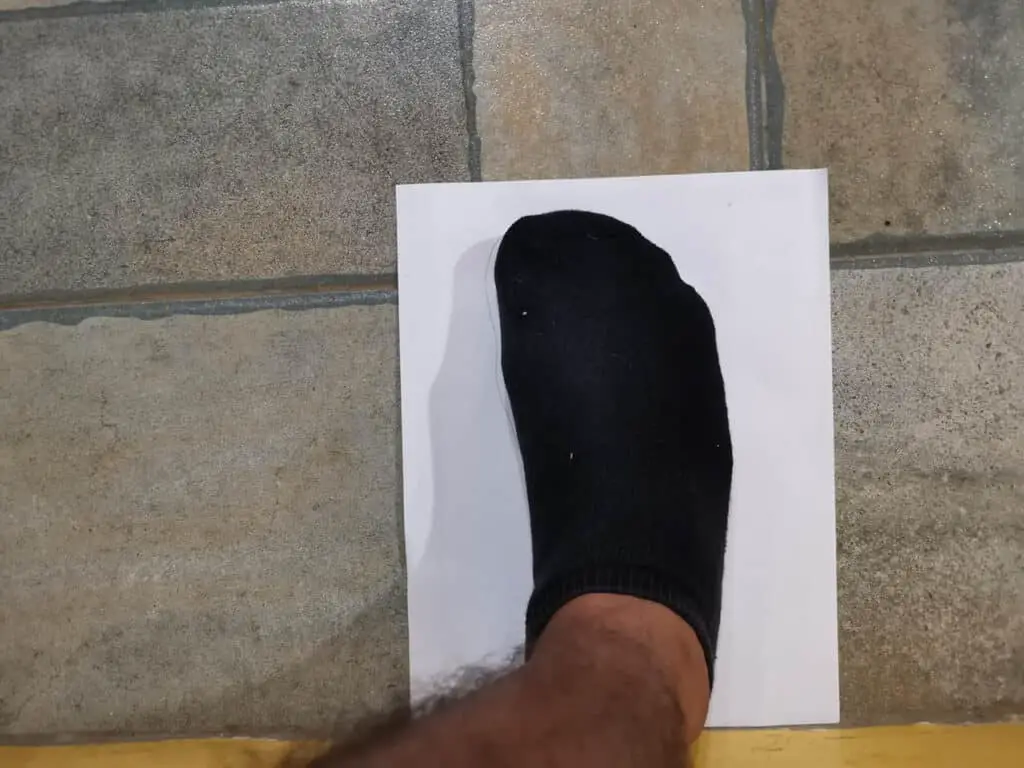
Outline both feet individually on a piece of paper 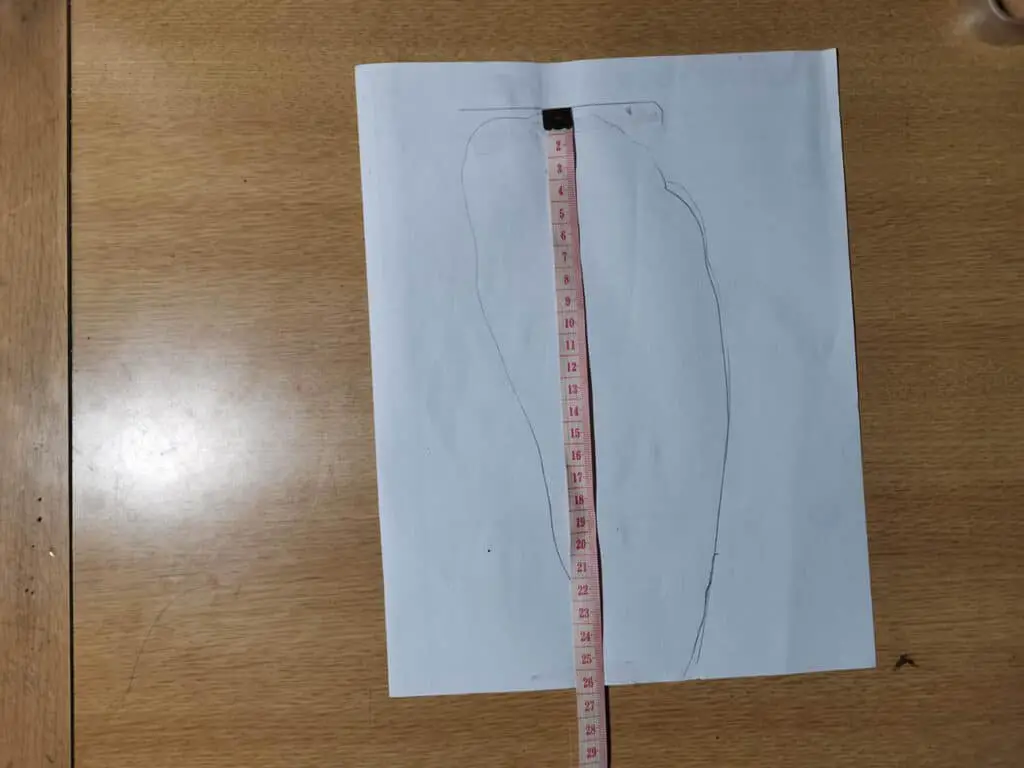
Measure your longer foot from the heel to the longest toe
Second, refer to the shoe manufacturer’s conversion chart. Most listings on Amazon and other online stores have a shoe chart you can refer to.
Using myself as an example, my longest foot length is 26 cm and I’ve added 1.5 cm (constant allowance) which equates to a total of 27.5 cm. Referring to the Brooks conversion chart below, it tells me that I should get a 9.5 (US size) shoe which is absolutely right on the spot.
| US | CM |
| 6 | 24.5 |
| 6.5 | 25 1/4 |
| 7 | 25 |
| 7.5 | 25.5 |
| 8 | 27 |
| 8.5 | 26.5 |
| 9 | 27 |
| 9.5 | 27.5 |
| 10 | 28 |
| 10.5 | 28.5 |
Typically, your running shoes will be a half size bigger than your casual shoes. In my case, my casual shoes are only 9 (US size) which confirms the size I got from the conversion chart.
Third, wait for your running shoe to arrive and try it on immediately. Don’t run with it or remove any tag whatsoever. You need to keep it intact so you can easily return it if it doesn’t fit.
I suggest you check the company’s return policy before making a purchase.
The next question will be how do you know if it fits or not? Generally, the shoe should feel snug around the heel and midfoot. It should have at least half your thumb’s width allowance from your longest toe to the top of the shoe and your heel must provide little to no movement on the heel counter.
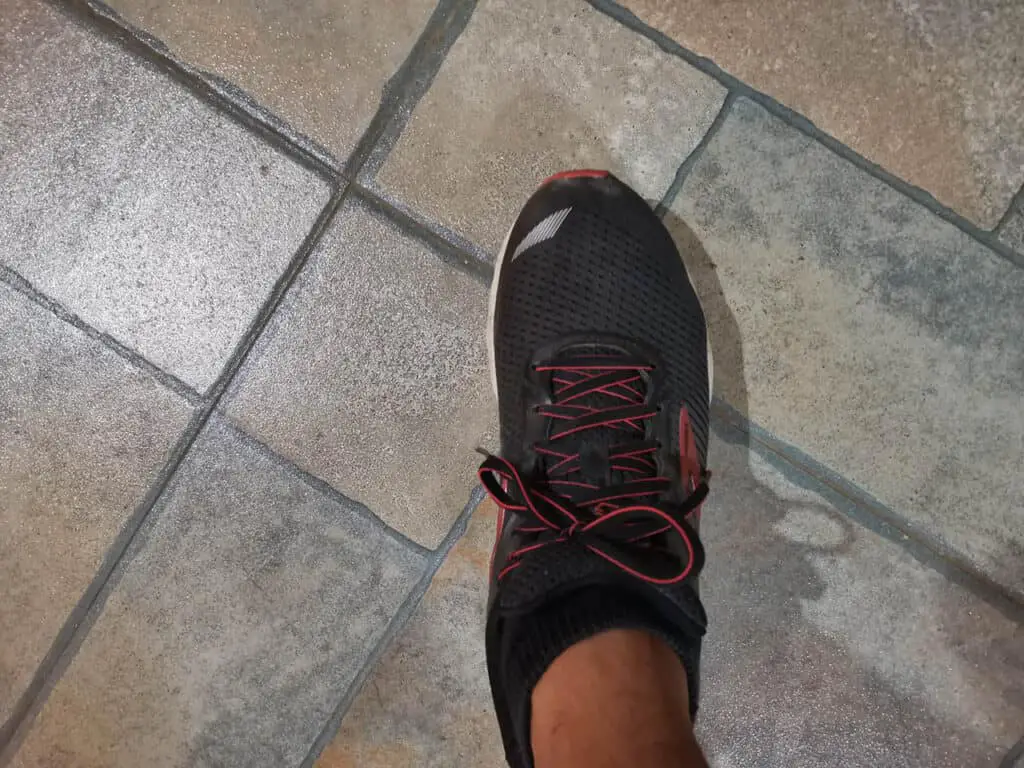
Shoe eyelets are parallel 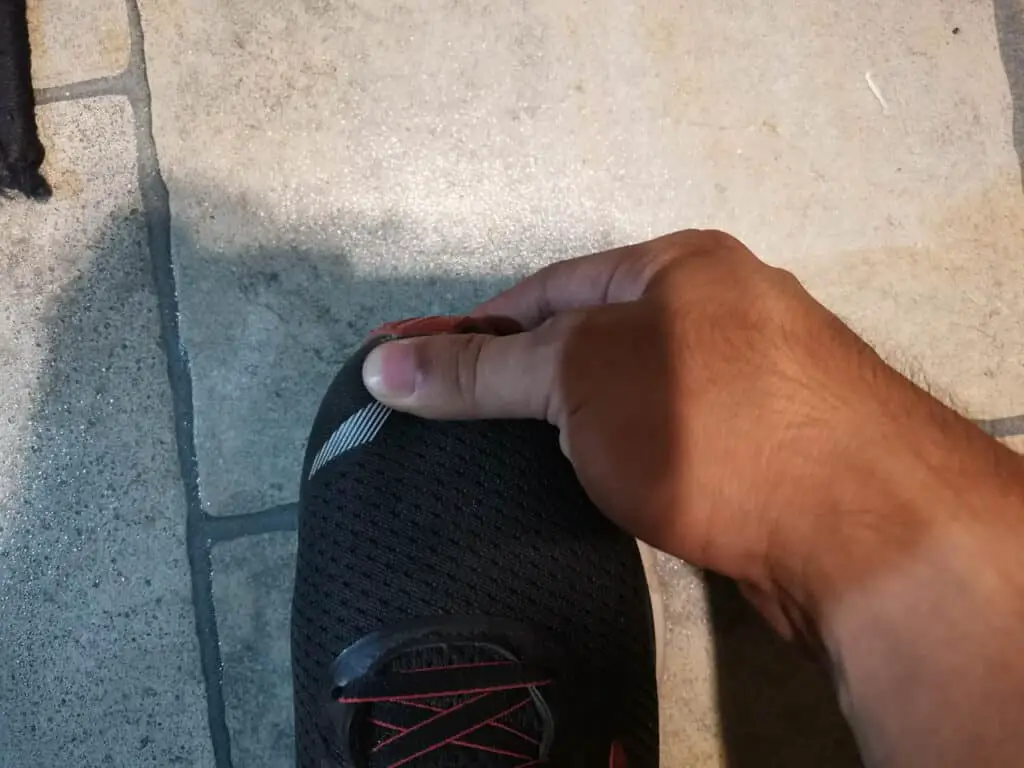
Half your thumb’s width allowance 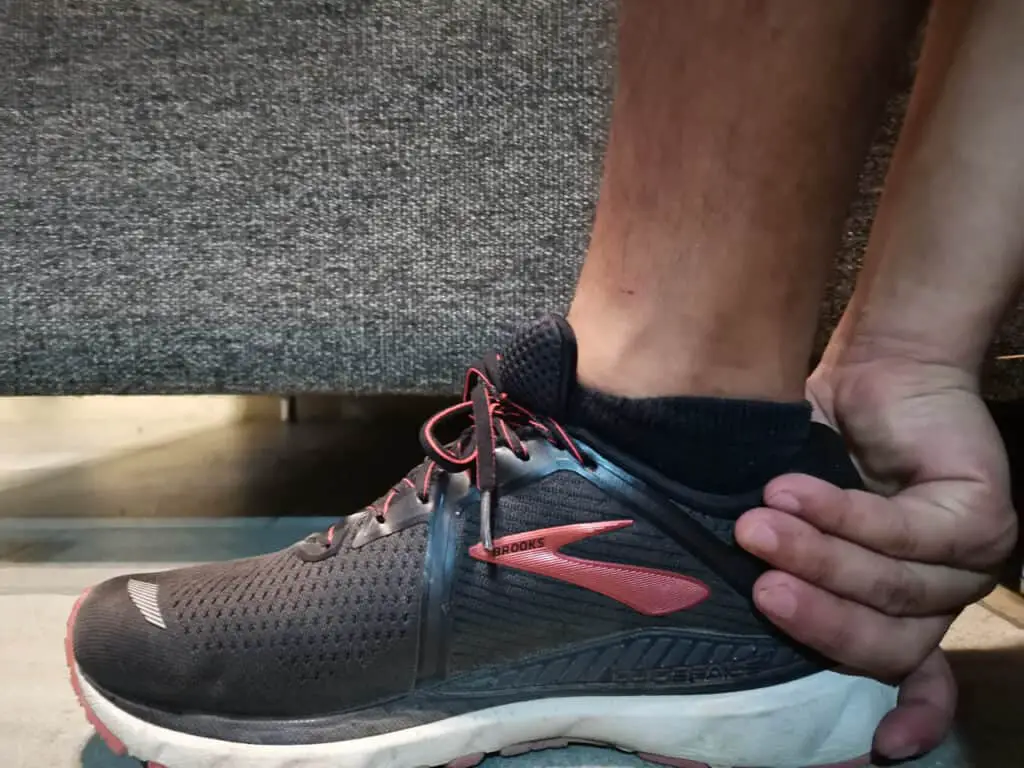
No heel lifts
If you need to know more about running shoe fit, I made an article that explains that in detail.
The Best Place To Buy Running Shoes Online
If you’re in a rush and you’ve already figured out what shoe you’re looking for, there’s no better place than Amazon.com. They have super fast delivery that will drastically cut the waiting time.
However, if you need to use running shoe filters according to running types, stack height, level of stability, etc, RunRepeat.com and RunningWarehouse.com are great places to buy.
Running shoe brands have their own websites too. Most of them have more detailed descriptions, product highlights, and filters. So if you’re loyal to a brand, be sure to check out their websites.
The Wrap Up
To wrap up this article, I’m going to leave you with a summary of what we’ve talked about.
Choose your running shoe
- Know the running surface
- Type of running you’ll mostly do
- Know the support level your foot needs
- Research the shoe before you buy
Get the size right
- Measure your foot from the heel to your longest toe in cm
- Refer to the running shoe size chart to get your size conversion
- Try it on immediately after it arrives but don’t use it or lose anything (including receipt)
There are a plethora of running shoes each with unique features making it really scary to buy online. Especially when you can’t try them on or ask the experts.
But when you’re armed with the correct information that will teach you a process to buy the right running shoes, you can be confident about buying shoes online.
